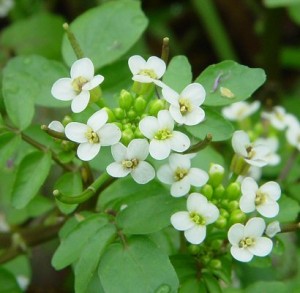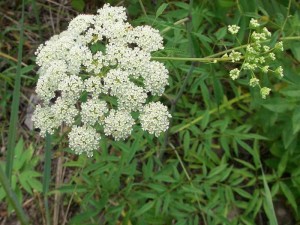Sometimes a toxic plant can give even an experienced forager reason to pause.
When I was making a video last week I saw a beautiful growth of watercress, Nasturtium officinale (though names can vary.) Like all the wild plants in the mustard family, it is a short-lived resident here in Florida, one to two months under the best of cool conditions. It lasts longer father north. As I write this is late February and the water cress is starting to blossom so it will soon be gone.
The cause for the pause was… it was growing in and among Water Hemlock, Cicuta maculata, which is about as close to sudden death as a plant can get. How sudden? You have 40 minutes to get your stomach pumped out. The last death on record from eating Water Hemlock — based on non-identification — was only last year. One brother died and another sickened in the 90s, and two died in 1975, a forest ranger who should have known better and a boy who made a whistle out of the stem. Three people avoided death that same year via a bystander who came upon them eating the hemlock. A high-speed 45-mile drive to the hospital and stomach pumping saved them all.
Water Hemlock and Watercress grow in similar environments. I like watercress. Cooked it’s a delicious and wholesome green. It does not look like Water Hemlock and does not have the same growth pattern. The Water Hemlock tends to be a yellow green and tall, the Watercress is a deep green — rare for Florida — and low growing. The leaves are different et cetera but… when one is picking Watercress in and among Water Hemlock one picks carefully because you are only one leaf away from death. One leaf. And, when it comes time to cook, inspecting every stalk of Watercress is imperative.
Now … all of that seems quite reasonable. Eat the right plant and avoid the deadly one. Yet, one of the hardest aspects of foraging is having good judgment and trusting your judgment. Desire is a strong drive and there is a tendency even among experienced foragers to make a plant “fit” a description. “Arriving” as a forager is, in my opinion, the ability to want that plant to be what you think it is but being able to admit it is not.
So when one is picking Watercress among Water Hemlock it is an act of judgment and caution that puts your life on the line. Whenever a life is on the line by a judgment — your own or others — it is indeed time to pause for the cause and be certain.
(Incidentally, the deadly Water Hemlock is the only member of its family whose veins on the top side of the leaves go to the notches between leaf teeth rather than to the end of the teeth.)



